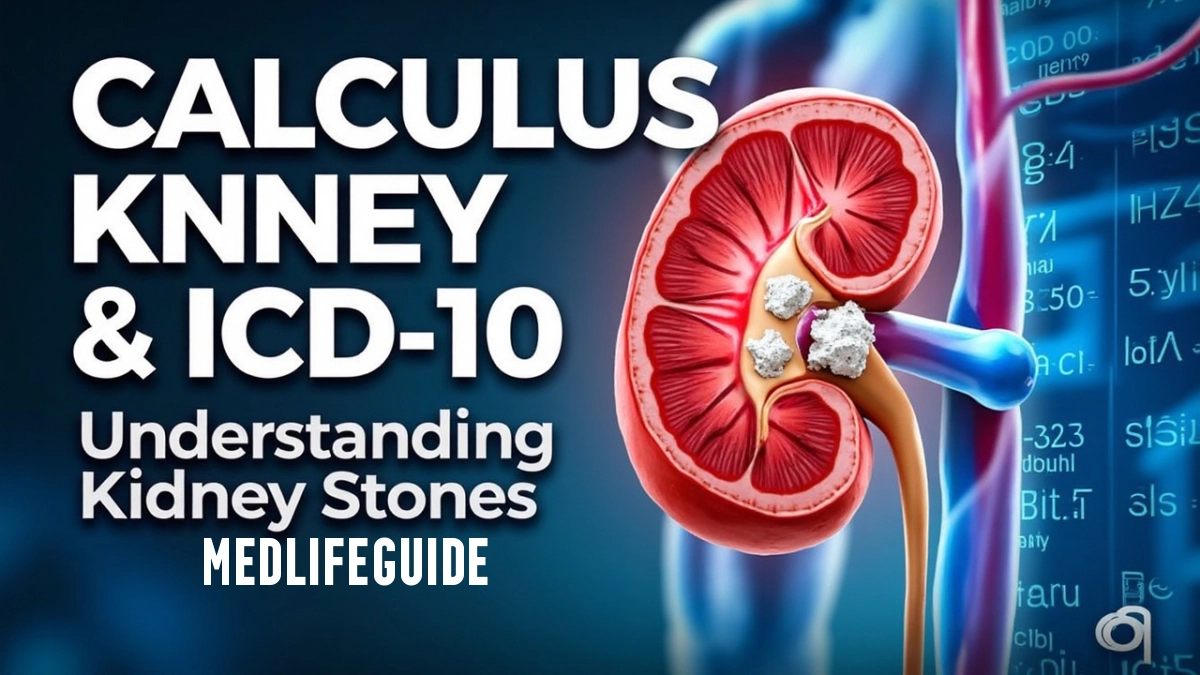Calculus of kidney, commonly known as kidney stones or nephrolithiasis, is classified under the ICD-10 coding system. This system helps healthcare providers document and bill for this condition accurately.
Primary ICD-10 Code
The primary ICD-10 code for kidney stones is N20. This code falls under the category of “Calculus of kidney and ureter” within Chapter XIV (Diseases of the genitourinary system).
Specific Codes Under N20
Under the N20 category, healthcare professionals use several specific codes based on the clinical presentation:
- N20.0: Calculus of kidney (stones located in the kidney)
- N20.1: Calculus of ureter (stones that moved from the kidney to the ureter)
- N20.2: Calculus of kidney with calculus of ureter (stones in both locations)
- N20.9: Urinary calculus, unspecified (when the specific location cannot be determined)
Additional Codes for Complications
The ICD-10 system also includes codes for complications and related conditions associated with kidney stones. Important codes include:
- N13.2: Hydronephrosis with renal and ureteral calculous obstruction (swelling of the kidney due to urine backup)
- Additional codes from the N10-N16 range for infections, such as pyelonephritis.
For recurrent kidney stones, healthcare providers may use Z87.442: Personal history of urinary calculi as a secondary code.
Importance of Proper Documentation
Proper documentation and coding of kidney calculus using ICD-10 codes is essential for:
- Accurate medical records
- Appropriate treatment planning
- Insurance reimbursement
- Epidemiological tracking
Healthcare providers must specify the location and size of the stones and any associated complications to select the most appropriate code. This detailed classification system ensures continuity of care and supports research into kidney stone prevalence and treatment outcomes. It also aids healthcare quality improvement initiatives focused on urological conditions.
Modifiers and CPT/ICD Pairing (Billing Relevance)
Common CPT Procedures for Kidney Calculus:
- 50590: Lithotripsy
- 52352: Ureteroscopy with removal
- 50080: PCNL (Percutaneous nephrolithotomy)
ICD-10 diagnosis codes like N20.0 must justify these CPT codes by supporting medical necessity.
If there’s infection or obstruction, always add codes such as:
- N13.6: Pyonephrosis
- R30.0: Dysuria (if documented)
Real-World Coding Scenarios
Case 1: “Right renal calculus with hydronephrosis”
- Primary Code: N13.2
- Secondary: Z87.440 (Personal history of urinary calculi) if recurrent
Case 2: “Multiple bilateral renal stones with pain”
- Code: N20.0
- Additional: R10.9 (Unspecified abdominal/pelvic pain)
Case 3: “Left ureteral stone causing obstruction”
- Primary: N20.2
Clinical Documentation Improvement (CDI) Tips
To assign the most accurate ICD-10 code, clinical documentation should answer:
- What is the location of the stone?
- Is there hydronephrosis, obstruction, or infection?
- Is it chronic, acute, or recurrent?
- Is there a history of stones?
CDI Queries might be needed if:
- Only “kidney stone” is mentioned with no site or severity
- Imaging confirms obstruction but physician note doesn’t
ICD-10 Coding Mistakes to Avoid
- Using N20.0 when the stone is clearly in the ureter
- Ignoring hydronephrosis or failing to code N13.2
- Missing history codes like Z87.440
- Overlooking related symptoms that justify workup or imaging
Related ICD-10 Codes for Kidney Stone Conditions
| Code | Description |
|---|---|
| Z87.440 | Personal history of urinary calculi |
| R10.9 | Unspecified abdominal pain |
| R30.0 | Dysuria |
| N13.6 | Pyonephrosis |
| N39.0 | Urinary tract infection, site not specified |
Code History
- 2016 (effective 10/1/2015): New code (first year of non-draft ICD-10-CM)
- 2017 (effective 10/1/2016): No change
- 2018 (effective 10/1/2017): No change
- 2019 (effective 10/1/2018): No change
- 2020 (effective 10/1/2019): No change
- 2021 (effective 10/1/2020): No change
- 2022 (effective 10/1/2021): No change
- 2023 (effective 10/1/2022): No change
For more information about kidney prevention click on the url: medlifeguide.com

